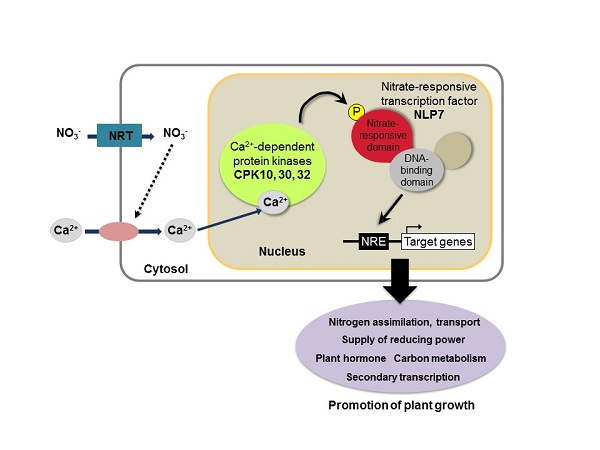Mechanism regulating growth in plants Calcium signaling and NLP transcription factors mediate response to nitrogen nutrients


Nitrate as nutrient signal promotes plant growth through transcriptional regulation
The rise in the concentration of calcium ions in plant cells that accompanies nitrate uptake activates calcium-dependent enzymes that phosphorylate NLP transcription factors. The phosphorylated NLPs become active and induce the expression of various genes to promote growth in plants.
© 2017 Shuichi Yanagisawa.
Researchers at the University of Tokyo and their collaborators have uncovered the mechanism in plants that picks out nitrate as a nutrient signal, and promotes growth and development. The current study points to the efficient use of agricultural fertilizer in the future.
Plants take up nitrogen sources such as ammonium and nitrate in soils and assimilate them to sustain growth. The nitrate absorbed by plants also functions as a signal that regulates metabolism and growth. Scientists have known for decades that plants adapt to nutrient conditions in the soil by detecting nitrate in the earth, but the mechanism by which they adapt remained unclear. However, several years ago, the nitrate signal was found to activate NLP transcription factors, instrumental in the adaptation process, to induce the expression of various genes.
In the current study, the research group led by Professor Shuichi Yanagisawa at the Biotechnology Research Center at the University of Tokyo and their collaborators revealed that nitrate uptake is accompanied by a rise in the concentration of calcium ions in the cell; this in turn activates enzymes dependent on the calcium ions that introduce a phosphate group and phosphorylate NLP transcription factors. The phosphorylated NLP transcription factors become active and promote plant growth by stimulating the expression of numerous genes including those for nitrogen assimilation and transport, carbon metabolism, and hormone metabolism.
Modern agriculture utilizes huge amounts of nitrogen fertilizers to increase the yields of agricultural fields. Understanding the mechanism by which nitrogen nutrients serve as a signal to regulate plant growth could lead to more efficient use of this type of fertilizer.
"Several years ago, we identified NLP transcription factors as key regulators for plants to adapt to nitrate in the soil; but we could not find out how the nitrate signal is relayed to the NLP transcription factors," says Yanagisawa. He continues, "I am very pleased that we were able to reveal the mechanism in our study this time."
The present study was carried out in collaboration with researchers at Harvard Medical School and the University of California, San Francisco in the U.S.
Paper
, "Discovery of nitrate–CPK–NLP signaling in central nutrient–growth networks", Nature Online Edition: 2017/05/10 (Japan time), doi: 10.1038/nature22077.
Article link (Publication)
Links
Laboratory of Plant Functional Biotechnology, Biotechnology Research Center






